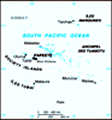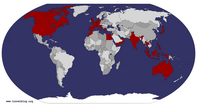Advertisement
Published: June 19th 2023
It seems we’re not staying in the quietest part of town. It’s 6am on what is now Sunday morning when music starts blaring through the window with enough volume to wake the dead. At least now we don’t need to worry about the alarm not going off. Today we’ve signed up for a tour across the island. We did something similar when we were here in 2014, and Issy’s decided against a repeat, leaving Scott and I to head off on our own. We pass Papeete’s central market where Sunday morning produce shopping’s in full swing - the whole place is bursting at the seams.
We hope we manage to survive the day. We contacted several tour companies before finding this one, and all said that they’d stopped doing Sunday tours. And why - well too much trouble apparently with drugs and alcohol … and they warned us not to let any rogue operators try to tell us any different. I wonder who Emma will get to walk her down the aisle in ten days time if we don’t manage to make it out of here alive this afternoon?
Our guide for the day introduces himself as Teuai, and
he couldn’t be any more Polynesian if he tried. He’s barefoot and dressed only in a traditional wraparound garment, and is covered from neck to toe in traditional tattoos. We’re joined by a couple from Seattle who are on their way to Bora Bora for their twenty-fifth wedding anniversary (this must be a thing - that’s what we did), and completing the party is a young couple from France and their impossibly cute three year old daughter … well we thought they were from France, but on closer interrogation it seems they’re actually from the small French island of Reunion off the east coast of Africa. So there’s a first; I’m fairly sure we’ve never met anybody from that particular neck of the woods before. I’d always thought that Reunion’s main claim to fame was fatal shark attacks. These guys seem to have all their limbs in tact, but I guess it’s possible they just haven’t lived there for very long.
We head around the east coast of the island and then inland up one of the river valleys. Teuai’s clearly passionate about his culture and the ancient ways, all of which he says were passed down to him
orally by his grandparents. He bemoans the loss of the current generation’s connection with nature. He says that obesity is the country’s current major health challenge, and it’s become this way because junk food‘s now so much cheaper than natural produce that that’s all everyone eats. But there are rays of hope. We’re told that the local pro-independence party won the recent election, and one of the first things they did was to mandate the reintroduction of teaching of the Tahitian language in schools, an idiom which Teuai tells us is at real risk of dying out.
He shows us a local fruit that smells exactly like strong blue cheese. We‘re told that it’s local name is “nono”, but apparently its juice is marketed internationally as “noni” juice - it seems the marketing guys thought it was a bit of a stretch to market something that was pronounced ”no no“. Next up is a walnut which he says is a proven cure for early stage thyroid cancer. And why is this important here? Well it seems that there have been thousands of deaths and many hundreds of ongoing cases annually of thyroid cancer and leukaemia locally as a direct
result of French nuclear testing, which started in the 1960s and only ceased as recently as 1996. There were somewhere around 200 tests in all over that period. The earlier ones were in the atmosphere, until worldwide political pressure forced them underground, not that that didn’t also come with its issues. We're told that there’s at least one atoll that’s been so weakened underneath that if there was an earthquake the whole place would sink into the ocean releasing disastrous quantities of highly toxic nuclear waste. Teuai's clearly completely disgusted by all of this, and in his words “the Polynesian people were lied to …. by decision makers 18,000 kilometres away”. Apparently to this day the French Government refuses to acknowledge that the astronomically abnormal rates of thyroid cancer and leukaemia here can be in any way attributed to the nuclear tests. When will we ever learn.
Teuai’s passion for the ancient ways is deeply rooted in connectedness to the environment. He’s a strong believer in traditional medicines, and the benefits of traditional plant based diets. Communication gets a gong too. He stops us next to a particular type of tree and bangs on it with a coconut. A
few seconds later the noise echoes back to us from far away across the valley. He tells us that this was how his ancestors communicated … and in the lower reaches of the valleys without so many of these trees they did it by blowing into conch shells.
We stop at a small pool in the river. Teuai pulls out a can of fish food and pours it onto a rock, and a few seconds later it’s crawling with dozens of eels. He says that eels do a great job of cleaning the water. If there are eels in there you know it’s safe to drink - well provided presumably you didn’t just dump a bunch of them in there a few seconds earlier….
We continue the long steep climb up the valley. The “road"’s now little more than a goat track and it‘s more than a bit bumpy perched in our open topped cabin on the back of Teuai’s truck. We’re told we’re now in the remnants of the crater. If these are the remnants the original must have been quite something. The scenery is beyond stunning - impossibly sheer towering jungle clad peaks all around us.
Teuai points out the tiny island’s highest peak, Mount Orohena, which at 2,241 metres is higher than anything the entire Australian continent can lay claim to, which is making me feel just a tad embarrassed.
We stop for a quick bite of lunch at a rustic ”resort” in the middle of the crater, then it’s on upwards yet again. The road’s deteriorated even further, if that was possible, and it’s now just a series of continuous tight, steep hairpin bends, with precipitous drops offs on one side hundreds of metres down into the valley below. We reach the top, well almost the top - a long narrow tunnel in the rock through to the other side of the range. And the reinforcing that’s presumably supposed to be holding the tunnel together - well most of that’s just hanging down off the walls. I hope they don’t get many earthquakes here, although I guess if they did at least it would be all over quickly.
We miraculously emerge unscathed out into the daylight and start the long journey down the other side. We thought the road up was a bit dodgy - this bit makes that one look like
an eight lane superhighway.
We stop for a break at an isolated flat spot where Teuai gives us a run down on the history of these valleys. When the Europeans first turned up the valleys’ total population was somewhere around 20,000. What is it now? Well it’s zero, zilch, nada. And why? Well that was almost entirely due to the white guys introducing smallpox, syphilis, tuberculosis and other assorted goodies which virtually wiped the local population out. The few that survived were then virtually bribed into converting to Christianity by the missionaries, who claimed that their own immunity to these diseases was due solely to their belief in the Christian god. Now I’m sure these guys were well intentioned, but really? The missionaries then went about trying to wipe out all remnants of the local culture - burning totems and other similar symbols, and forcing the recent converts to wear full length clothing to cover up their “evil” traditional tattoos. This brainwashing about the evils of tattooing was so effective that the taboo only eased as recently as the 1980s. It seems that in pre-European times a Polynesian couldn’t just rock up at a local parlour and request to
be inked up - tattoos had to be earned, akin to medals. Teuai explains some of his own personal engravings, all of which are linked strongly to traditional Polynesian spiritualism and connectedness to Mother Earth - the sun, the sea, stars, trees - you name it, he’s got a picture of it. And the connection to Mother Earth also explains his bare footedness - in his words you can’t be connected to the earth’s energy if you're not constantly touching it. And it seems that "tattoo" is a Polynesian word, derived from the noise that the sharpened tool makes as it digs constantly into your flesh. Ouch. And the connectedness to earth concept is all encompassing from birth, through life and onto death. Even westerners bury their dead, but the traditional Polynesians get this idea going from much earlier in the life cycle - they bury the placentas of newborns and plant trees in the soil above so they grow as the child grows. Hmmm.
As we head back to civilisation it’s a bit hard not to notice that we’ve yet to see anything even vaguely resembling boozing or drug taking. Scott reckons this was all just a convenient
ruse for some of the tour operators to get a day off…
Meanwhile back at the ranch, we’ve got an early morning flight tomorrow which means that we need to be up at 3am, which I’m sure will feel like several hours before we went to bed, and we need a taxi to pick us up at 4am. It seems that Issy’s been spending most of the day in a blind panic trying to find a taxi driver … any taxi driver … willing to collect us that early. It’d be a long walk, and I’m not sure Emma’d be overly pleased if we missed her wedding. Anyway persistence pays off and Issy's relieved to tell us she finally managed to force some poor lady cab driver into submission. I hope she turns up….
Advertisement
Tot: 0.077s; Tpl: 0.014s; cc: 14; qc: 31; dbt: 0.0408s; 1; m:domysql w:travelblog (10.17.0.13); sld: 1;
; mem: 1.1mb













D MJ Binkley
Dave and Merry Jo Binkley
Beauty Abounds
You make me want to book a flight.